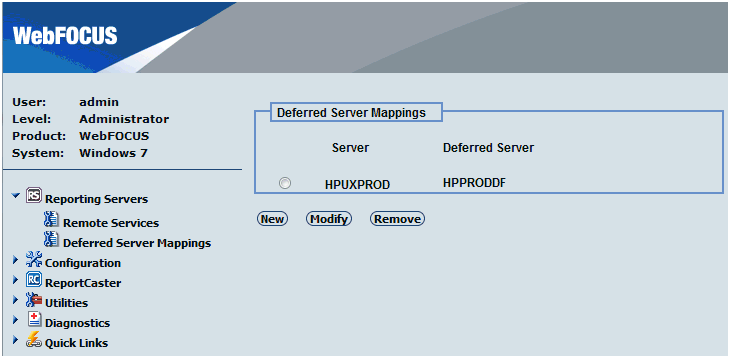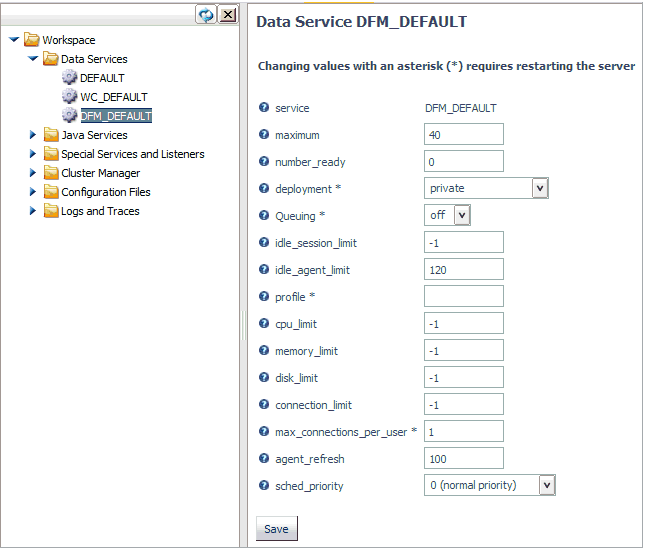Managing Deferred Workload
Because you can connect from a single WebFOCUS Client
installation to multiple WebFOCUS Reporting Servers, a single user
can have deferred tickets for output residing on multiple servers.
These servers can be on different platforms and may require different
user IDs. Users have access to all deferred output, regardless of
location, and are prompted for credentials automatically as needed.
There are administrator settings for managing deferred workload.
Each server can have an alternate deferred server to separate interactive
and deferred processing. You can limit the number of server agents
allocated to handling deferred requests and the number of deferred
requests a given user can process at one time.
Deferred request properties are available from the Reporting
Server Web Console. To access them, select Workspace from
the Web Console main menu, right-click DFM_DEFAULT in
the Data Services folder, and select Properties.
For more information, see the Server Administration for UNIX,
Windows, OpenVMS, IBM i, and z/OS manual.
xUnderstanding Alternate Deferred Servers
You can configure an alternate deferred server for one
or more of your interactive servers. This type of configuration
causes deferred requests to run against a specific server. For example,
if you are building a report in a domain that has a server set to
HPUXPROD, if you do not change this setting, the report runs against
HPUXPROD when run interactively or deferred. If you configure an
alternative deferred HPPRODDF server for the HPUXPROD server, deferred
requests are run against the HPPRODDF server because of the relationship
configured in the WebFOCUS Administration Console Reporting Servers Deferred
Server Mapping settings, as shown in the following image.

Configuring alternate deferred servers is one way to manage deferred
workload. Typically, the alternate deferred server is given fewer
processing resources because users are not waiting interactively
for the request to finish. This allows the interactive servers to have
relatively more processing resources.
If you do not have access to the WebFOCUS Administration Console,
contact your WebFOCUS Administrator or see the WebFOCUS Security
and Administration manual.
xConfiguring Deferred Services
You can also manage the resources allocated to processing
deferred requests without configuring additional servers. In the
Reporting Server Web Console, you can use the DFM_DEFAULT properties
in the Data Services folder to configure
workload settings for the DEFAULT data server. Each data server
has a DFM service for which you can configure workload settings
for deferred requests, independent of interactive requests.
For example, the default max_connections_per_user value of -1
does not impose a limit on the number of deferred requests a user
can submit. You can change the max_connections_per_user value to
1 for the DFM_DEFAULT Data Service while allowing users to submit
unlimited concurrent interactive requests, as shown in the following
image.

If you do not have access to the WebFOCUS Server Web Console,
contact your WebFOCUS Server Administrator or see the Server
Administration for UNIX, Windows, OpenVMS, IBM i, and z/OS manual.
xDeferred Report Expiration Setting
The WebFOCUS Reporting Server has an output expiration
setting that controls when deferred output is purged from the WebFOCUS
Reporting Server. This setting is configured using the Reporting
Server configuration file (Windows and UNIX) and the deferred receipt
listener node block (on z/OS).
x
Syntax: How to Control Purging of Deferred Output
dfm_maxage={0|n}where:
- 0
Indicates no expiration is configured.
- n
Indicates n days until expiration. 30 is the default.
No
setting means that the default of 30 days will be in effect.
The
number of days until expiration are displayed in the Managed Reporting
Deferred Status Interface next to each report. On the last day,
the Today value is displayed.
Note: Cleanup
of deferred output stored on the WebFOCUS Reporting Server is facilitated
by the Deferred Management listener, which checks every time it
wakes up. The sleep interval for the listener is defined by the
dfm_int_max parameter which defaults to 30 seconds if not specified.
For more information about this and related parameters, see Deferred
Management Properties in the Listeners and Special Services chapter
of the Server Administration for UNIX, Windows, OpenVMS, IBM i,
and z/OS manual or the Web Console Help system.
If a deferred report is not
saved or deleted prior to its expiration, the output is automatically
deleted from the WebFOCUS Reporting Server dfm_dir directory and
the deferred report is moved to the Unknown category in the Deferred
Report Status Interface. From the Unknown category, the user can
only delete the unknown report. For more information about cleaning
up unknown deferred tickets, see Managing the Deferred Ticket Cleanup Utility.

